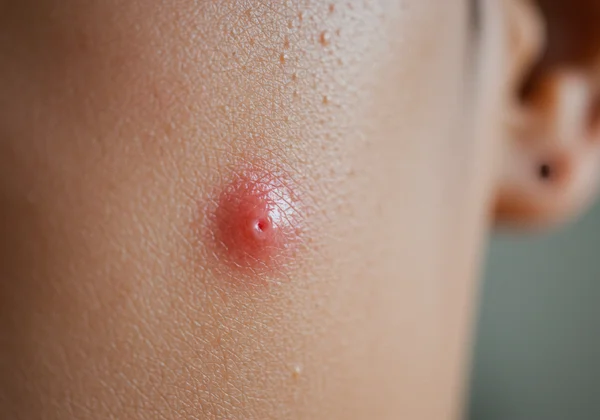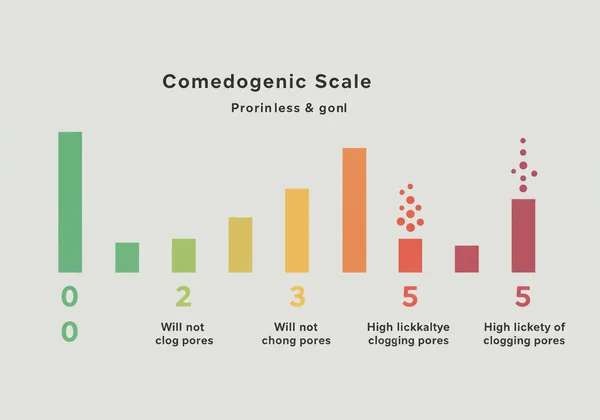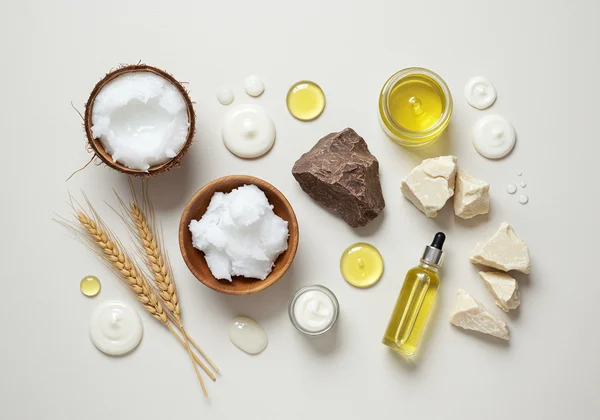毛穴を詰まらせる成分とは?チェッカーで調べよう
丁寧なスキンケア ルーティンを続けているのに、なかなか治らない肌荒れに悩んでいませんか?洗顔、化粧水、保湿と全てのステップを踏んでいるのに、新しい吹き出物が次々と現れる。その隠れた犯人は、実は身近なところに潜んでいるのかもしれません。もしあなたが常に、「 毛穴を詰まらせる成分って何? 」と自問自答しているなら、あなたは一人ではありません。このガイドでは、これらの肌トラブルの原因となる成分を明らかにし、あなたの肌の健康を再びコントロールできる強力な 毛穴詰まりチェッカー をご紹介します。
クリアな肌への道のりは、知識から始まります。どの成分が肌に悪影響を及ぼすかを理解することが、最初にして最も重要なステップです。購入時に推測に頼るのではなく、情報に基づいた選択ができるようになります。信頼できる スキンケア成分チェッカー を使えば、毎日の製品に潜む隠れた犯人を最終的に突き止め、あなたの肌の目標を真にサポートするルーティンを構築することができます。

コメドジェニック成分とは?
コメドジェニック成分チェッカー を効果的に使用する前に、その用語を理解することが不可欠です。「コメドジェニック」という言葉は美容業界でよく使われますが、その意味はしばしば誤解されています。この概念を理解することが、ニキビができにくいスキンケア レジメンを構築するための基礎となります。
「コメドジェニック」の意味を解説
簡単に言えば、コメドジェニック成分とは、毛穴を詰まらせる傾向がある成分のことです。毛穴が古い角質、皮脂、製品の残留物の混合物で詰まると、「コメド」が形成されるのに最適な環境が作られます。コメドとは、黒ずみ(開放面皰)や白ニキビ(閉鎖面皰)として知られる小さな隆起のことです。
これらの詰まった毛穴が細菌によって炎症を起こすと、赤ニキビ(丘疹)や膿疱といったより重度のニキビへと発展する可能性があります。したがって、ニキビや毛穴詰まりを起こしやすい人にとって、コメドジェニック性の高い成分を避けることは主要な戦略となります。だからこそ、効果的な ニキビ対策製品チェッカー は、肌に触れる前に問題となりうる処方をふるいにかけるために非常に価値があるのです。
コメドジェニック スケール(0-5)の理解
成分を分類するために、科学者は一般的に0から5までのコメドジェニック スケールを開発しました。このスケールは、成分が毛穴の詰まりを引き起こす可能性を測定するために、しばしばウサギの耳を対象とした研究に基づいて作成されました。
-
0: 毛穴を詰まらせない。
-
1: 毛穴を詰まらせる可能性が非常に低い。
-
2: 毛穴を詰まらせる可能性が中程度に低い。
-
3: 毛穴を詰まらせる可能性が中程度。
-
4: 毛穴を詰まらせる可能性がかなり高い。
-
5: 毛穴を詰まらせる可能性が高い。

このスケールは役立つ出発点ですが、完璧なものではありません。4または5の評価は強い注意すべき点ですが、成分の効果は人によって劇的に異なる場合があります。 ノンコメドジェニック チェッカー を使用すると、これらの高リスク成分をすばやく特定できますが、常にあなたの肌が最終的な判断を下すことを忘れないでください。
肌タイプと処方が重要な理由
成分のコメドジェニックな可能性は絶対的ではありません。2つの重要な要素が関係します。それは、あなたの独自の肌タイプと製品全体の処方です。ココナッツオイル(評価4)のようなオイルは、脂性肌やニキビができやすい肌の人にとっては肌トラブルの原因となる可能性がありますが、非常に乾燥していて反応性の低い肌の人にとっては無害であるか、あるいは有益でさえあるかもしれません。
さらに、成分の濃度も重要です。3という中程度の評価の成分でも、リストの最初の5つの成分の1つであれば問題となる可能性がありますが、リストの最後に記載されていれば(つまり、ごく少量しか含まれていない場合)、全く問題ないかもしれません。この複雑さがあるため、数少ない「悪い」成分を記憶しようとするよりも、全成分リストを瞬時に分析できる便利なツールの方がはるかに実用的です。
避けるべき一般的な毛穴詰まり成分のリスト
専用の ニキビ成分チェッカー が最も信頼できる方法ですが、最も一般的な問題となる成分をいくつか知っておくことで、潜在的な注意すべき点を素早く見つけることができます。これらの成分は、保湿剤からファンデーションまで、驚くほど幅広い製品に含まれています。

重いオイルとバター
これらは保湿特性でしばしば賞賛されますが、非常に閉塞性が高く、皮脂や古い角質を閉じ込める膜を形成する可能性があります。ニキビができやすい肌や脂性肌の人にとっては、肌荒れの頻繁な引き金となります。
- ココナッツオイル: 多くの用途で有名ですが、コメドジェニック評価が4と高いです。
- ココアバター: 評価4のもう一つのリッチなエモリエントで、ボディクリームによく配合されていますが、顔用製品にも忍び込んでいることがあります。
- 大豆油: あまり知られていませんが、中程度から高い評価があり、一部の人にとっては問題となることがあります。
- 小麦胚芽油: 非常に栄養価が高いですが、評価が5と高く、特に注意すべき成分です。
特定の藻類エキスと脂肪酸
このカテゴリーには、しばしば脂肪や油から派生したもの、または化粧品処方でテクスチャー向上剤として機能する成分が含まれます。これらはニキビができやすい人にとって特に問題となり、クリーミーな製品やローションベースの製品によく見られます。
- ミリスチン酸イソプロピル: コメドジェニック評価が5と高い一般的なエモリエントです。
- パルミチン酸イソプロピル: ミリスチン酸イソプロピルと同様に、スケールで高いスコアを獲得しています。
- ラウレス-4とオレス-3: これらはコメドジェニック性が高いことで知られる乳化剤です。
- アルゲエキス: 自然で無害に聞こえますが、特定の種類は強力な毛穴詰まりの原因となる可能性があります。
メイクアップとヘアケア製品に潜む意外な犯人
あなたのニキビは、スキンケア製品が原因ではないかもしれません。生え際、背中、胸の吹き出物は、シャンプーやコンディショナーの洗い流しが原因であることがよくあります。ここで ヘア製品ニキビチェッカー が非常に貴重なツールとなります。
- ラノリン: 羊の毛から抽出されるこの成分は、深い保湿力がありますが、多くの人にとってコメドジェニックとなる可能性があります。
- ラウリル硫酸ナトリウム (SLS): 主に刺激の強い洗浄剤として知られていますが、敏感肌の人にとっては毛穴を詰まらせる刺激物となることもあります。
- 特定の赤色染料: チークや口紅によく使用される一部のD&C赤色染料は、吹き出物との関連が指摘されています。
製品が毛穴を詰まらせるかどうかを確認する方法
これで「何が」と「なぜ」は理解できたでしょう。しかし、最も重要な疑問が残っています。この知識をどう効率的に活用するか?誰もが製品ラベルに記載された一つ一つの成分を科学データベースと照合する時間はありません。ここで、テクノロジーがシンプルで洗練された解決策を提供します。
成分表示を読むことの課題
あらゆる化粧品の裏側を見てください。INCI(国際化粧品成分命名法)リストとして知られる、複雑な化学名の長いリストが見つかるでしょう。これらの何十もの名前のうち、どれが安全でどれが潜在的な脅威であるかを記憶しようとすることは、圧倒的で非現実的な作業です。
このフラストレーションは一般的で正当なものです。それは試行錯誤のサイクルにつながり、時間、お金、そして肌への自信を失わせます。安全な保湿剤を買うためだけに、化粧品科学の学位が必要なわけではありません。目標は、あなたに代わって大変な作業を行い、明確な「はい」または「いいえ」を教えてくれるシステムを見つけることです。
シンプルな解決策:ニキビ成分チェッカー
ここで、当社の無料 毛穴詰まりチェッカー が、あなたのスキンケアへのアプローチを変革します。当社の無料かつ公平なツールは、あなたに瞬時の明確さを提供するように設計されています。あなたはもはや製品が安全であるかどうかを推測したり、願ったりする必要はありません。数秒で確実に知ることができます。
プロセスは信じられないほどシンプルです。
-
製品のウェブサイトまたはパッケージから、全成分リストを コピー します。
-
リストを当社のホームページにあるチェッカーに 貼り付け ます。
-
「チェック」 をクリックして、当社の包括的で科学に基づいたデータベースと照合し、成分を瞬時に分析します。

このツールは、見つかった潜在的にコメドジェニックな成分をすぐにハイライト表示し、自信を持って決定を下せるようにします。店内で購入を検討している場合でも、自宅で現在のルーティンを監査している場合でも、答えは常にあなたの指先にあります。
肌荒れにうんざりしていませんか?推測をやめて、知りましょう。
数秒であなたのスキンケアに潜む隠れた犯人を暴き出しましょう。以下の成分リストを貼り付けて、無料の即時分析を受け、よりクリアな肌への第一歩を踏み出しましょう。 今すぐ成分をチェックする
免責事項:この記事は情報提供のみを目的としており、医学的アドバイスを構成するものではありません。ここに提供される情報は、いかなる肌の状態も診断、治療、または治癒することを意図していません。肌の悩みについては、常に資格のある皮膚科医または医療専門家にご相談ください。
スキンケア成分チェッカーでコントロールを取り戻そう
試行錯誤のイライラするサイクルを止めましょう。マーケティングの主張に選択を左右されるのではなく、力をあなたの手に取り戻しましょう。知識はクリアな肌への鍵であり、私たちのチェッカーはそれを解き放つツールです。
今日からあなたのスキンケアの旅を力強く進めましょう。新しい製品を購入する前に必ず分析する習慣をつけましょう。私たちの 無料分析ツール を使用して、現在のルーティンを検証し、隠れた成分がずっと問題を引き起こしていたかどうかを発見しましょう。
毛穴詰まり成分に関するあなたの疑問にお答えします
毛穴詰まりチェッカーの使い方は?
当サイトの 毛穴詰まりチェッカー の使用方法は、非常に簡単です。製品の全成分リストを見つけ、そのテキスト全体をコピーし、当社のホームページの入力ボックスに貼り付けるだけです。ワンクリックで、ツールは当社のデータベースと各項目を照合し、既知の毛穴詰まりの原因となる成分をハイライト表示します。これは ニキビ対策の成分をチェックする 最も速い方法です。
「ノンコメドジェニック」と表示された製品は常に安全ですか?
残念ながら、そうではありません。「ノンコメドジェニック」という用語はFDAによって規制されていません。これは、どのブランドも厳格な標準化されたテストなしにそのラベルを貼ることができることを意味します。このラベルが貼られた多くの製品は確かにニキビができやすい肌にとってより安全に処方されていますが、一部の製品は特定の個人にとって問題となる成分を依然として含んでいる可能性があります。確実な唯一の方法は、公平なツールで 成分を自分で分析する ことです。
ニキビができやすい肌のために避けるべき成分は何ですか?
具体的な引き金は様々ですが、注意すべき一般的な成分には、ココナッツオイルやココアバターのような重い閉塞性のオイルやバター、ミリスチン酸イソプロピルのような特定の脂肪酸エステル、そしてラノリンのようなヘア製品に潜む意外な犯人などが挙げられます。リストを暗記する代わりに、最も効果的な戦略は、検討している製品の包括的な分析を得るために、当社の無料 コメドジェニック成分チェッカー を使用することです。